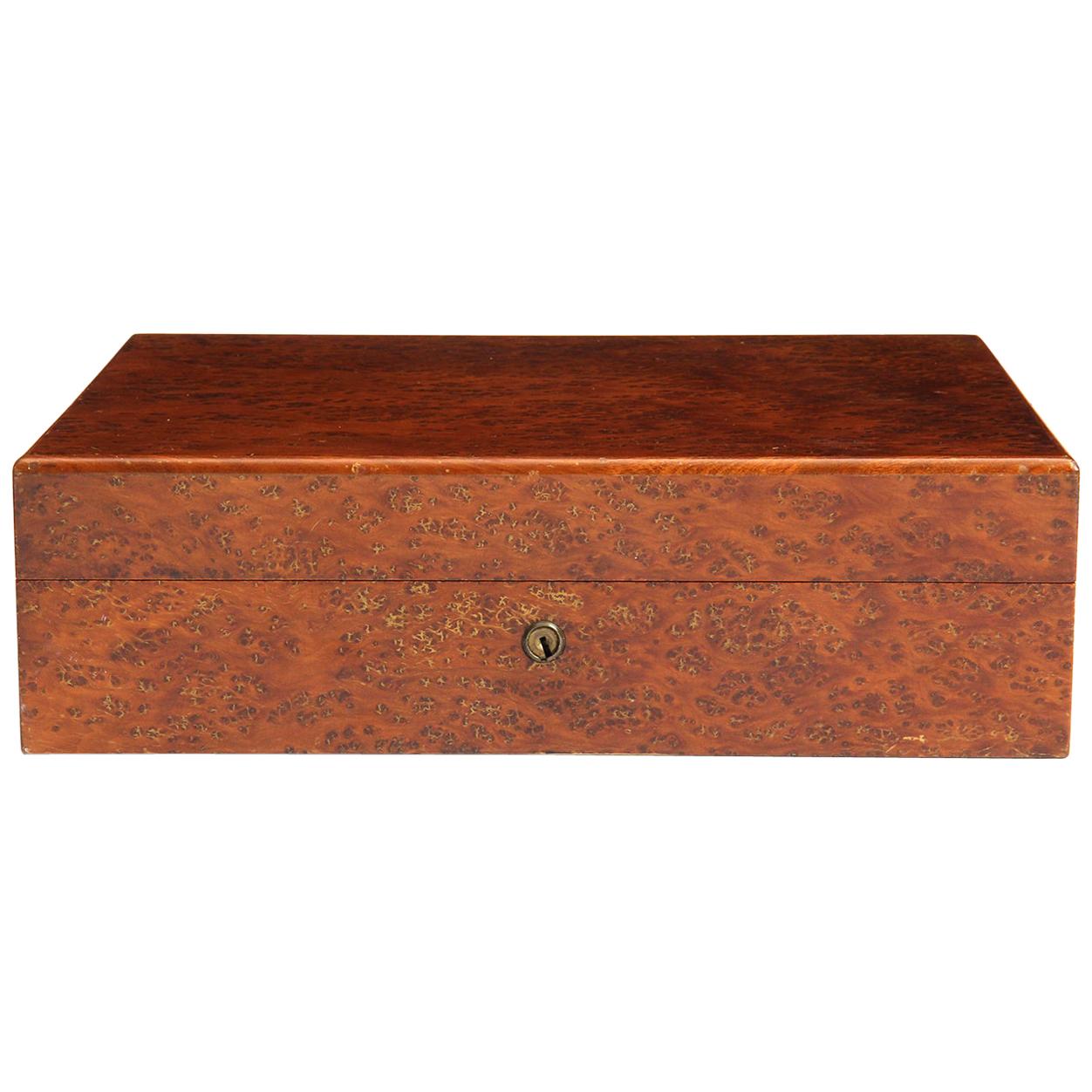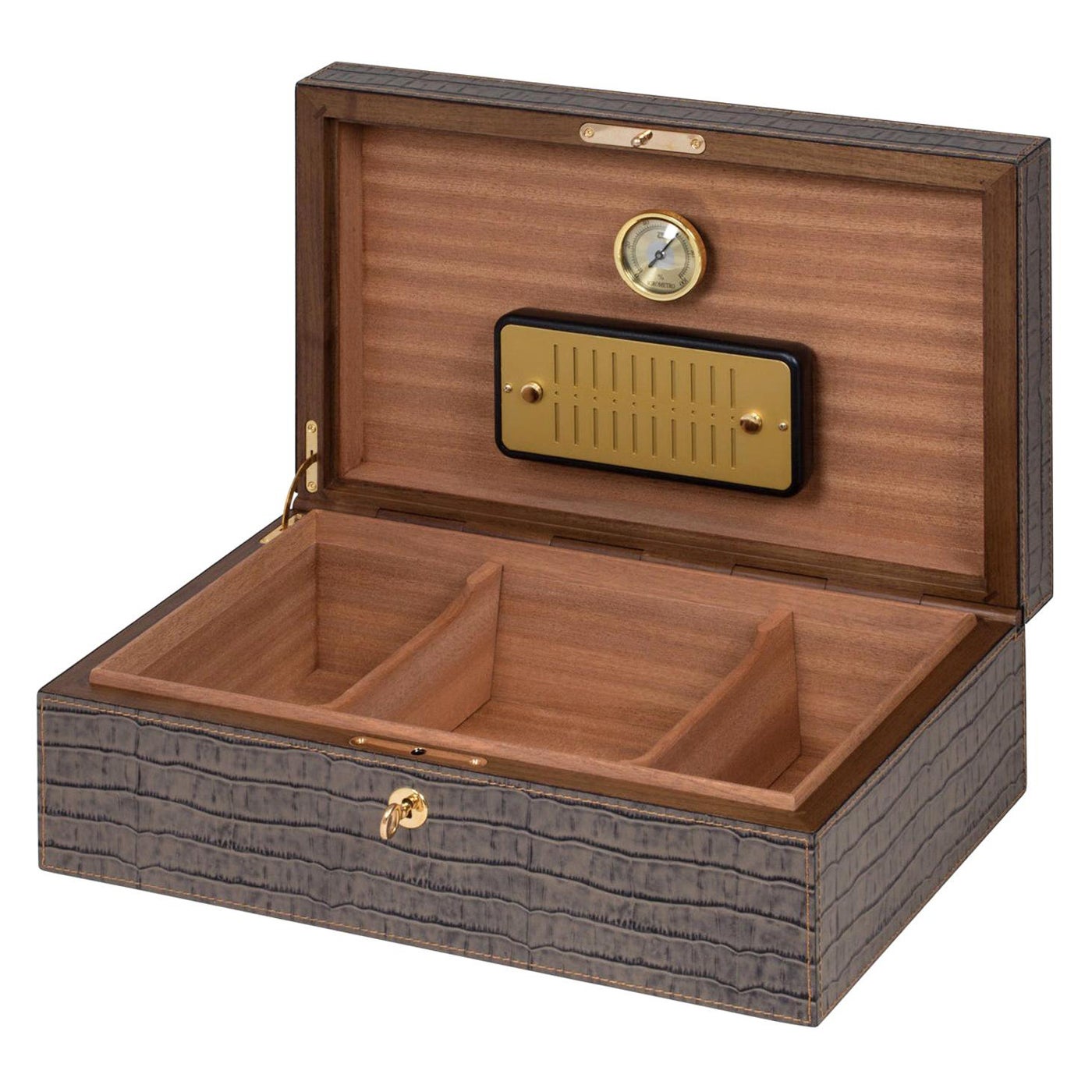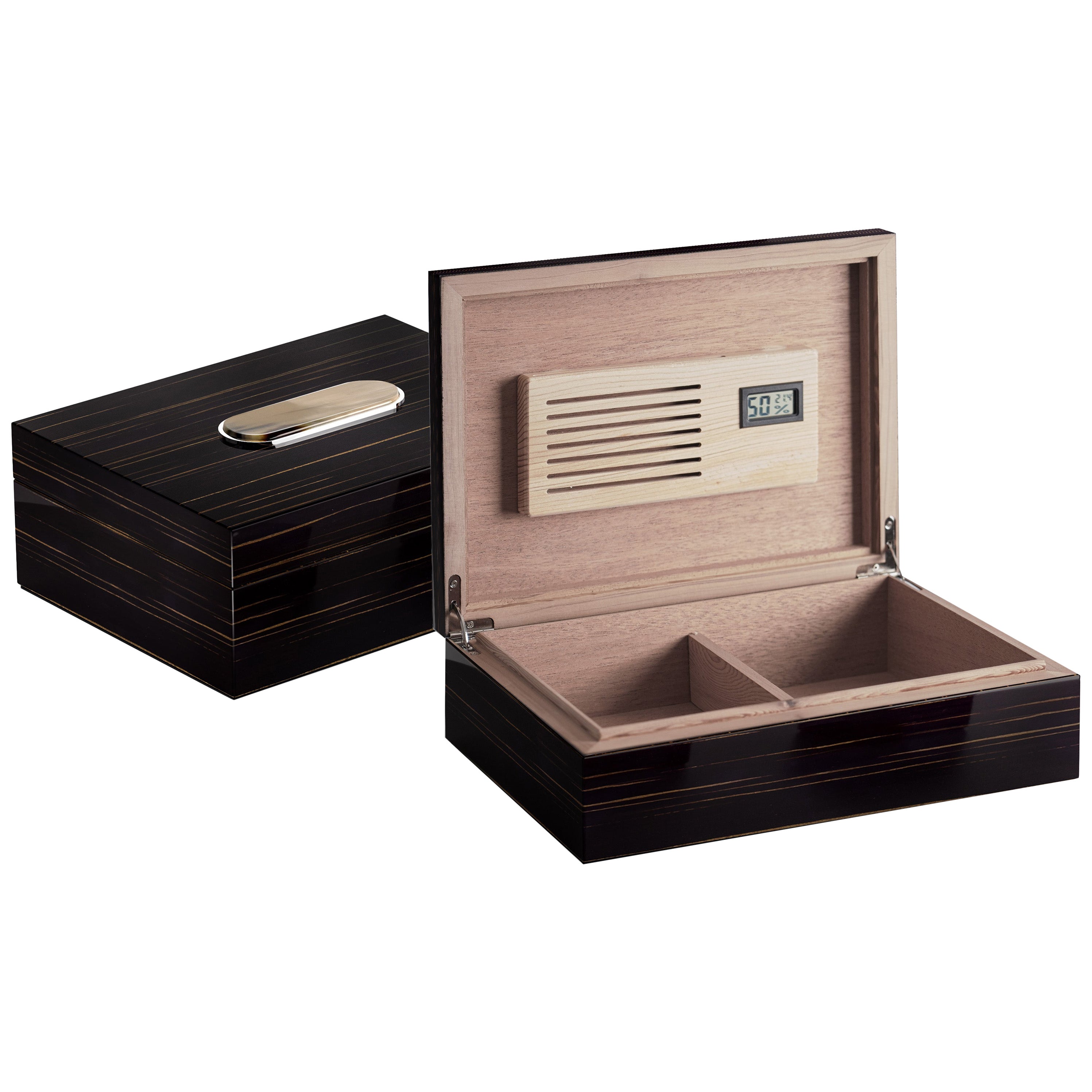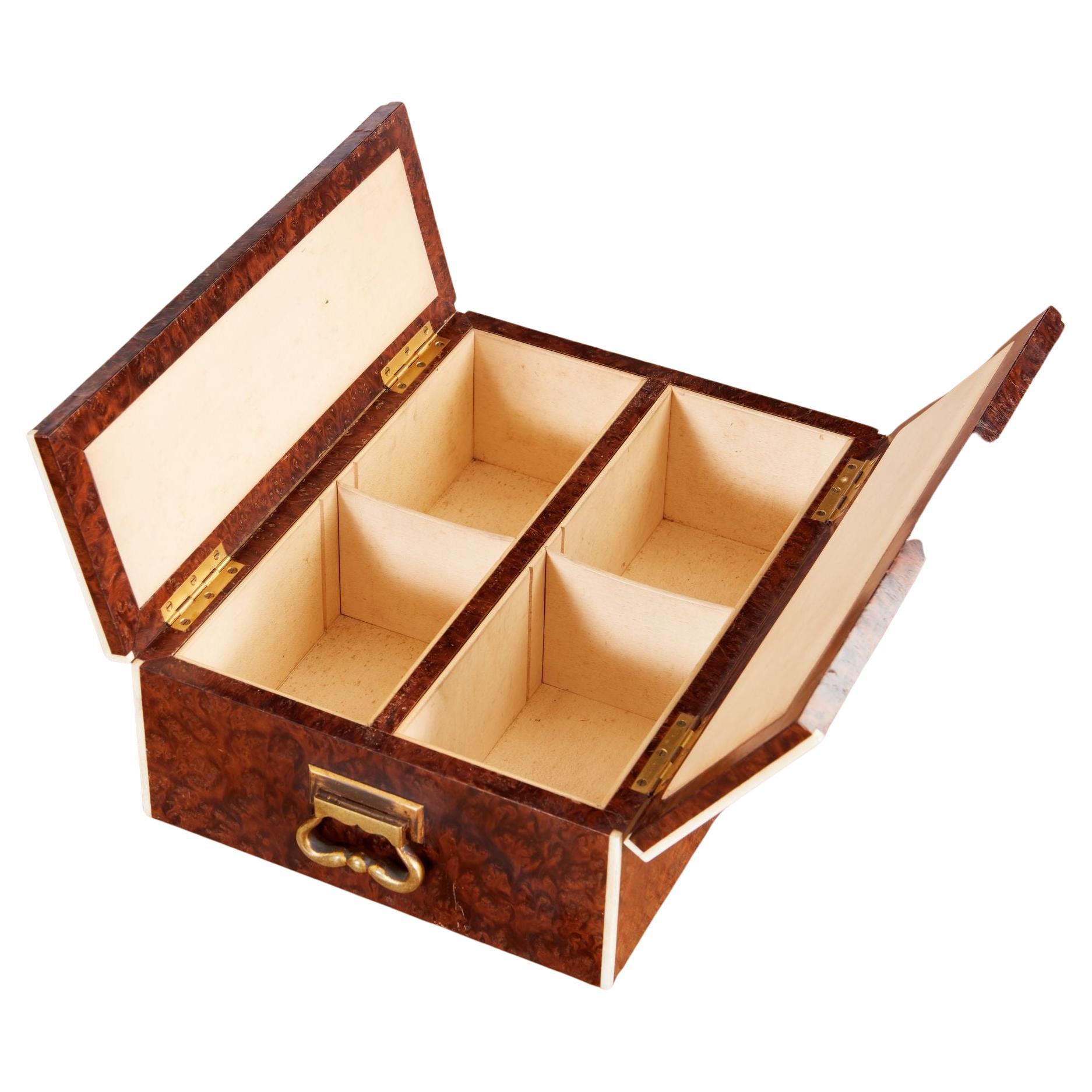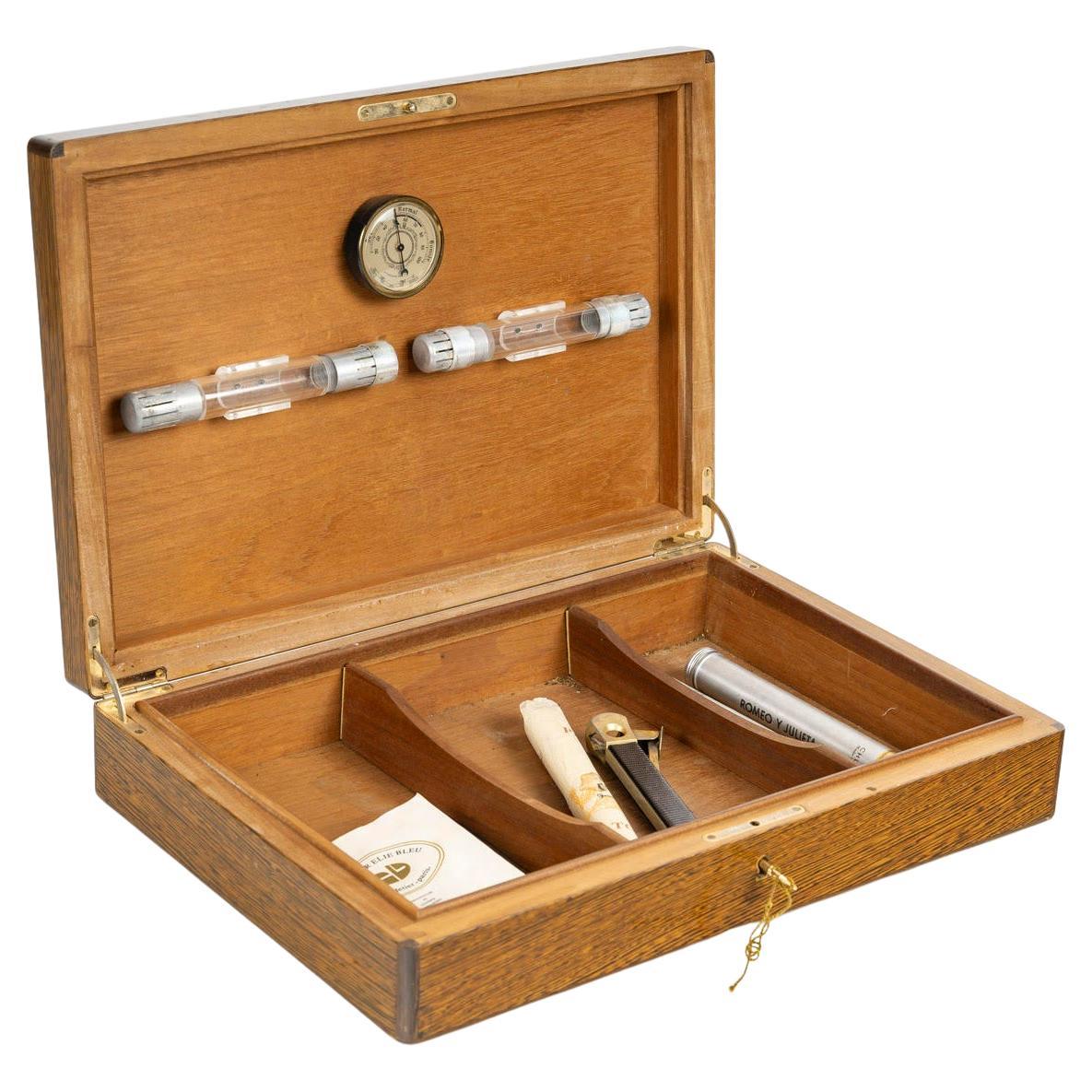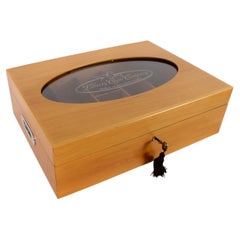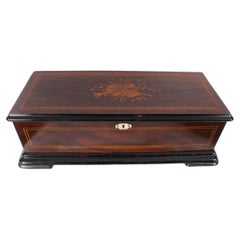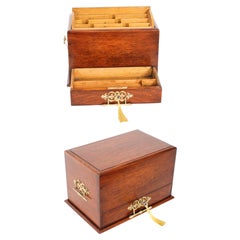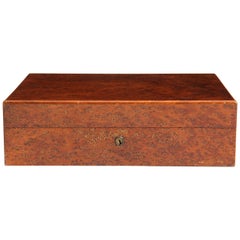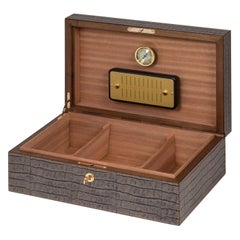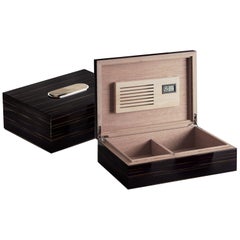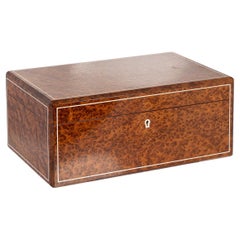Items Similar to Vintage Savinelli Karelian Birch Humidor Harrods Mid 20th Century
Want more images or videos?
Request additional images or videos from the seller
1 of 18
Vintage Savinelli Karelian Birch Humidor Harrods Mid 20th Century
$1,190.95
£850
€1,018.25
CA$1,624.45
A$1,818.74
CHF 953.62
MX$22,471.62
NOK 12,016.25
SEK 11,342.86
DKK 7,597.39
Shipping
Retrieving quote...The 1stDibs Promise:
Authenticity Guarantee,
Money-Back Guarantee,
24-Hour Cancellation
About the Item
An superb and elegant Vintage Karelian Birch humidor with fitted interior by the renowned manufacturer Savinelli, retailed by the legendary retailer Harrods, mid 20th century in date.
The rectangular humidor features a a striking Karelian Birch high gloss exterior with ebony edging and a Spanish cedar-lined interior, with two divisions, which helps to keep the aroma of the cigars and equipped with a humidification system.
The humidor has a very stylish and timeless design and would make any cigar connoisseur very happy.
THE BOTANICAL NAME FOR THE MAHOGANY THAT THIS ITEM IS MADE OF IS SWIETENIA MACROPHYLLA AND THIS TYPE OF MAHOGANY IS NOT SUBJECT TO CITES REGULATION AND DOES NOT CONTAIN ANY RESTRICTED MATERIALS.
Condition:
In really excellent condition, please see photos for confirmation of condition.
Dimensions in cm:
Height 11 cm x Width 29 cm x Depth 22 cm
Dimensions in inches:
Height 4 inches x Width 11 inches x Depth 9 inches
Savinelli Humidors
Founded in 1876, Savinelli is a well-respected Italian brand in the cigar world, known for producing high-quality smoking accessories and humidors. Their humidors are crafted from premium materials, such as Spanish cedar, and are designed to keep cigars at optimal humidity levels, preserving their flavor and aroma. Savinelli's humidors are not only functional but also stylish, featuring elegant finishes and classic design elements. The brand has a reputation for excellence and is trusted by cigar enthusiasts around the world. If you are looking for a humidor that is both practical and attractive, Savinelli is a great choice. Whether you have a large collection or just a few special cigars, a Savinelli humidor is a must-have item for any smoker looking to keep their cigars in top condition.
Harrods founder Charles Henry Harrod first established his business in 1824, aged 25. The business was located south of the River Thames in Southwark. The premises were located at 228 Borough High Street.
He ran this business, variously listed as a draper, mercer and a haberdasher, certainly until 1831. During 1825 the business was listed as 'Harrod and Wicking, Linen Drapers, Retail', but this partnership was dissolved at the end of that year. His first grocery business appears to be as ‘Harrod & Co.Grocers’ at 163 Upper Whitecross Street, Clerkenwell, E.C.1., in 1832. In 1834 in London's East End, he established a wholesale grocery in Stepney, at 4, Cable Street, with a special interest in tea.
In 1849, to escape the vice of the inner city and to capitalise on trade to the Great Exhibition of 1851 in nearby Hyde Park, Harrod took over a small shop in the district of Brompton, on the site of the current store. Beginning in a single room employing two assistants and a messenger boy, Harrod's son Charles Digby Harrod built the business into a thriving retail operation selling medicines, perfumes, stationery, fruit and vegetables. Harrods rapidly expanded, acquired the adjoining buildings, and employed one hundred people by 1880.
However, the store's booming fortunes were reversed in early December 1883, when it burnt to the ground. Remarkably, in view of this calamity, Charles Harrod fulfilled all of his commitments to his customers to make Christmas deliveries that year—and made a record profit in the process. In short order, a new building was built on the same site, and soon Harrods extended credit for the first time to its best customers, among them Oscar Wilde,Lillie Langtry, Ellen Terry, Charlie Chaplin, Noël Coward, Gertrude Lawrence, Laurence Olivier and Vivien Leigh, Sigmund Freud, A. A. Milne, and many members of the British Royal Family.
On Wednesday, 16 November 1898, Harrods debuted England's first "moving staircase" (escalator) in their Brompton Road stores; the device was actually a woven leather conveyor belt-like unit with a mahogany and "silver plate-glass" balustrade. Nervous customers were offered brandy at the top to revive them after their 'ordeal'. The department store was purchased by the Fayed brothers in 1985.
In 2010 Harrods was sold to Qutar Holdings.
Harrods was the holder of royal warrants from 1910 till 2000 from the following:
* Queen Elizabeth II (Provisions and Household Goods)
* The Duke of Edinburgh (Outfitters)
* The Prince of Wales (Outfitters and Saddlers)
* The late Queen Elizabeth, the Queen Mother (China and Glass)
The store occupies a 5-acre (20,000 m2) site and has over one million square feet (90,000 m2) of selling space in over 330 departments making it the biggest department store in Europe.
The UK's second-biggest shop, Selfridges, Oxford Street, is a little over half the size with 540,000 square feet (50,000 m2) of selling space, while the third largest, Allders of Croydon had 500,000 square feet (46,000 m2) of retail space.
By comparison Europe's second-largest department store the KaDeWe in Berlin has a retail space of 650,000 square feet (60,000 m2).
Karelian Birch
Karelian Burr Birch Wood is is found between Finland and Russia in the region of Karelia. This wood can create an absolutely stunning, one of a kind piece of furniture. It is a very pretty wood which is similar to Birdseye Maple.
Mostly used for highly decorative furniture and historically the Tsars furniture " The Imperial Furniture" was made in Karelian Birch Burr.
Humidor
is any kind of box or room with constant humidity that is used to store cigars, cigarettes, orpipe tobacco. For private use, small wooden or acrylic glass humidor boxes for a few dozen cigars are used, while cigar shops may have walk-in humidors.
Humidors can be used to store other goods for which a certain level of humidity is desirable; the Colorado Rockies Major League Baseball team stores game balls in a large humidor at their home stadium, Coors Field, to counteract the effects of Denver's high altitude and generally low humidity. Humidors of all sizes use hygrometers to keep track of the humidity levels.
Classification of humidors
Walk-in humidor - most common in cigar bars or stores. One room is built as or converted to a humidor where all the cigars are stored.
Cabinet humidor - usually placed on the floor as a piece of furniture. Typically holds 1000-5000 cigars.
Table humidor - often quite heavy, though portable in theory, it's usually kept in one location. Capacity ranges from three hundred to a few thousand cigars. It usually comes with a polished wood exterior, marble, leather or combination of exotic elements, and glass top.
Personal humidor - semi-regular cigar smokers will sometimes keep a small humidor in their homes for personal storage, special events, or aesthetic characteristics of the humidor itself . Usually contains 20-75 cigars. This may also be known as a "Desktop Humidor".
Travel humidor - portable and made for carrying cigars enough for the outing or event, usually 2 to 10 cigars.
Our reference: A4254
- Creator:Savinelli design (Manufacturer)
- Dimensions:Height: 4.34 in (11 cm)Width: 11.42 in (29 cm)Depth: 8.67 in (22 cm)
- Materials and Techniques:Birch,Cedar
- Place of Origin:
- Period:
- Date of Manufacture:Mid-20th Century
- Condition:
- Seller Location:London, GB
- Reference Number:Seller: A42541stDibs: LU950642646312
About the Seller
5.0
Platinum Seller
Premium sellers with a 4.7+ rating and 24-hour response times
Established in 1983
1stDibs seller since 2012
1,363 sales on 1stDibs
Typical response time: <1 hour
Associations
LAPADA - The Association of Arts & Antiques Dealers
- ShippingRetrieving quote...Shipping from: London, United Kingdom
- Return Policy
Authenticity Guarantee
In the unlikely event there’s an issue with an item’s authenticity, contact us within 1 year for a full refund. DetailsMoney-Back Guarantee
If your item is not as described, is damaged in transit, or does not arrive, contact us within 7 days for a full refund. Details24-Hour Cancellation
You have a 24-hour grace period in which to reconsider your purchase, with no questions asked.Vetted Professional Sellers
Our world-class sellers must adhere to strict standards for service and quality, maintaining the integrity of our listings.Price-Match Guarantee
If you find that a seller listed the same item for a lower price elsewhere, we’ll match it.Trusted Global Delivery
Our best-in-class carrier network provides specialized shipping options worldwide, including custom delivery.More From This Seller
View AllVintage Fruitwood Display Humidor Mid 20th Century
Located in London, GB
An elegant Vintage English fruitwood humidor with fitted interior, mid 20th century in date.
The rectangular humidor features a hinged lid having an oval cut out with a glass viewi...
Category
Mid-20th Century Cigar Boxes and Humidors
Materials
Fruitwood
Antique Swiss 8 Air Gonçalo Alves Musical Box 19th Century
Located in London, GB
This is a lovely antique Swiss 8 airs Gonçalo Alves cylinder music box, manufactured by Qualite Excelsior Sondrite Extra Puissant Harmonie, circa 1870 in date.
The Goncalo Alves case is inlaid and crossbanded with boxwood inlay and superb marquetry decoration of musical instruments. It is raised on a plinth base and is fitted with brass carrying handles.
The music box features a 28cm cylinder playing eight tunes with arrow and adjustable lyre damper, with handwritten "Tremolo a Zither" play sheet and makers plate for Qualite Excelsior Sondrite Extra Puissant Harmonie.
Condition:
In excellent working condition, please see photos for confirmation.
Dimensions in cm:
Height 28 cm x Width 66 cm x Depth 22 cm
Dimensions in inches:
Height 11 inches x Width 2 foot, 2 inches x Depth 9 inches
Music box
(also musical box) is a 19th/20th century automatic musical instrument that produces sounds by the use of a set of pins placed on a revolving cylinder or disc so as to pluck the tuned teeth (or lamellae) of a steel comb. They were developed from musical snuff boxes of the 18th century and called carillons à musique...
Category
Antique 1870s Decorative Boxes
Materials
Wood
Antique Edwardian Oak stationery cabinet Early 20th Century
Located in London, GB
A rare antique Edwardian oak stationery cabinet of rectangular outline, the swing top with fall front enclosing fitted compartments, Circa 1900 in date.
The cabinet features ormolu ...
Category
Antique Early 1900s Decorative Boxes
Materials
Oak
Antique Victorian Brass Bound Oak Cigar Humidor 19th Century
Located in London, GB
This is a stylish antique Victorian oak brass and cedar lined tabletop cigar humidor circa 1860 in date.
The rectangular box features a lift out tray and adjustable divisions with sunken handles to the sides and a hinged lid with a central brass shield.
Complete with the original Bramah lock and key.
It would make a beautiful gift to any connoisseur of fine cigars.
Condition:
In excellent condition. As an antique items, the humidor shows signs of use commensurate with age, these minor condition issues are mentioned for accuracy and, as seen in the accompanying photographs, it displays beautifully.
Dimensions in cm:
Height 19.5 x Width 44 x Depth 29
Dimensions in inches:
Height 8 inches x Width 1 foot, 5 inches x Depth 11 inches
Humidor
is any kind of box or room with constant humidity that is used to store cigars, cigarettes, orpipe tobacco. For private use, small wooden or acrylic glass humidor boxes for a few dozen cigars are used, while cigar shops may have walk-in humidors.
Humidors can be used to store other goods for which a certain level of humidity is desirable; the Colorado Rockies Major League Baseball team stores game balls in a large humidor at their home stadium, Coors Field, to counteract the effects of Denver's high altitude and generally low humidity. Humidors of all sizes use hygrometers to keep track of the humidity levels.
Classification of humidors
Walk-in humidor - most common in cigar bars or stores. One room is built as or converted to a humidor where all the cigars are stored.
Cabinet humidor - usually placed on the floor as a piece of furniture. Typically holds 1000-5000 cigars.
Table humidor - often quite heavy, though portable in theory, it's usually kept in one location. Capacity ranges from three hundred to a few thousand cigars. It usually comes with a polished wood exterior, marble, leather or combination of exotic elements, and glass top.
Personal humidor - semi-regular cigar smokers will sometimes keep a small humidor in their homes for personal storage, special events, or aesthetic characteristics of the humidor itself . Usually contains 20-75 cigars. This may also be known as a "Desktop Humidor".
Travel humidor - portable and made for carrying cigars enough for the outing or event, usually 2 to 10 cigars.
Oak
is a tree or shrub in the genus Quercus - Latin "oak tree" having approximately 600 extant species. Oak wood has a density of about 0.75 g/cm3, great strength and hardness, and is very resistant to insect and fungal attack because of its high tannin content. It also has very appealing grain markings, particularly when quartersawn. Oak wood is very durable, easy to maintain and resistant to wear and tear which is why it can be easily handed to the next generations if taken well care of.
Oak wood virtually lasts forever and you can still admire oak furniture in museums and palaces even if it was made many centuries ago. Oak has been prized since the Middle Ages for use in interior panelling of prestigious buildings such as the debating chamber of the House of Commons in London and in the construction of fine furniture.
Bramah
is London's oldest security company. Established at 124 Piccadilly, London in 1784, and today based in Marylebone, London and Romford, Essex.
Bramah made their first lock in 1784 and the patent was awarded in 1787. The designer was Joseph Bramah. Joseph Bramah was a leading inventor of the industrial revolution, patenting over 18 new ideas, including a new valve for the water closet (toilet), the hydraulic pump, a fountain pen, and a fire engine.
Bramah also introduced a beer hand pump for use at the bar, to prevent fluid loss when barmen went downstairs to pour a new jug! Due to the quality of his manufacturing, his name became a by-word amongst British Engineers for engineering excellence and many of his inventions are on display in the Science Museum in London. You can find one of his original toilets still working in Osborne House, Queen Victoria's home on the Isle of Wight.
The Bramah lock was unique and advanced property and valuables protection enormously. Indeed it was 50 years ahead of any Chubb lock...
Category
Antique 1860s English Victorian Cigar Boxes and Humidors
Materials
Oak, Cedar
Antique Victorian Gonçalo Alves Vanity Box 1860s
Located in London, GB
This is a magnificent antique Victorian Gonçalo Alves table top Vanity Box, circa 1860 in date.
The fitted interior reveals a lift-out compartment tray, dressed with a green velve...
Category
Antique 1860s Victorian Decorative Boxes
Materials
Hardwood
Antique Coromandel Writing/ Stationary Cabinet by Houghton and Gunn 19th Century
By William Houghton and Charles Gunn
Located in London, GB
A very fine antique Victorian Coromandel writing or stationary cabinet made by the world famous London box makers and retailers Houghton and Gunn, dated December 1878.
The wonderfu...
Category
Antique 1870s Victorian Decorative Boxes
Materials
Wood
You May Also Like
Humidor from USA
Located in Sagaponack, NY
A humidor made of warmly toned burled maple with a cedar and glass interior.
Category
Vintage 1950s American American Craftsman Cigar Boxes and Humidors
Materials
Maple, Cedar
$1,800
Large Santiago Humidor
By Giobagnara
Located in Milan, IT
This superb humidor is a perfect gift or precious companion for the cigar lover. The walnut wood case is externally covered with fine leather that can be customized in color and text...
Category
2010s Italian Cigar Boxes and Humidors
Materials
Leather, Walnut, Cedar
$1,035 / item
Sibilla Humidor in Glossy Ebony and Corno Italiano, Mod. 2458
By Arcahorn Srl.
Located in Recanati, Macerata
Tailored for discerning smoking enthusiasts, the Sibilla cigar humidor blends exquisite materials with sophisticated design. Crafted with the utmost care, the humidor features an ext...
Category
21st Century and Contemporary Italian Cigar Boxes and Humidors
Materials
Wood
Vintage 20thC Art Deco Burr Walnut Cigar Humidor By Dunhill, England c.1930
By Dunhill
Located in Royal Tunbridge Wells, Kent
A lovely Art Deco burr walnut humidor by Dunhill, dating to the 1930s. The rectangular humidor features a burr walnut veneer exterior with framed stringing on each panel and a chamfe...
Category
20th Century British Other Cigar Boxes and Humidors
Materials
Walnut
Fine Amboyna Burl Humidor by Callow of Mount Street
Located in Greenwich, CT
Very fine early 20th century humidor fashioned from solid amboyna burl with bone trim and lacquered brass carrying handles, by Callow of Mount Street, hav...
Category
Vintage 1920s English Cigar Boxes and Humidors
Materials
Bone, Amboyna
Cigar Case, Veneered Wood, 20th Century.
Located in Saint-Ouen, FR
Cigar case, veneered wood, 20th century.
Cigar case, veneered wood, 20th century.
H: 9cm, W: 39cm, D: 27cm
Category
20th Century French Art Deco Cigar Boxes and Humidors
Materials
Wood
More Ways To Browse
Christmas Box
Perfume Box
Mid Century Cigarette
Vintage Acrylic Box
Vintage Cigar Room
Record Bar
Silver Storage Box
Wood Carrying Box
Wood And Sons Plate
Made In Italy Perfume
Wills Cigarettes
Vintage Cigarette Table
Vintage Smokers
Expandable Game Table
Decorative Balls Glass
Cigarette Box Wood
Record Holder
Cabinet Plate Royal
